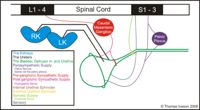Difference between revisions of "Urinary System Overview - Anatomy & Physiology"
(→Kidney) |
|||
| Line 8: | Line 8: | ||
==Introduction== | ==Introduction== | ||
| − | |||
| − | |||
| Line 21: | Line 19: | ||
The kidneys are responsible for the production and release of two [[The Endocrine Function of the Kidney - Anatomy & Physiology|hormones]]- Erythropoietin and Renin, which are produced in the Juxtaglomerular Cells. The kidneys also regulate the activation of vitamin D. | The kidneys are responsible for the production and release of two [[The Endocrine Function of the Kidney - Anatomy & Physiology|hormones]]- Erythropoietin and Renin, which are produced in the Juxtaglomerular Cells. The kidneys also regulate the activation of vitamin D. | ||
| + | |||
| + | [[Transport Across Membranes - Physiology| Transport Across Membranes]] | ||
| + | |||
==Lower Urinary Tract== | ==Lower Urinary Tract== | ||
Revision as of 13:45, 19 June 2010
|
|
Introduction
Kidney
The function of the kidneys is to maintain the volume and composition of plasma, regulate water, ion and pH levels, retain nutrients and excrete waste, toxins and excess electrolytes. The kidneys achieve these functions via glomerular filtration, solute reabsorption, tubular secretion, water balance and acid-base regulation.
The kidneys are paired organs which reside in the left hand side and right hand side of the dorsal abdomen respectively. Their role is to filter the blood through the renal corpuscle; this comprises a capillary tuft known as a glomerulus which is surrounded by the Bownam's capsule within the nephron, and the movement of fluid and soluble material across these structures forms what is known as the filtrate. The filtrate is then on the whole reabsorbed along the nephron until what is left comprises compounds superfluous to the requirements of the organism. Some compounds, normally fully reabsorbed, are on occasion present in the body in excess. The kidney tubules are able to respond to this excess and excrete such compounds in greater amounts. This is how the kidneys play a major role in the homeostasis of the organism. The kidneys also plays a vital role in the total water balance of the organism, varying their excretion of water in relation to the hydration status of the animal.
The kidneys receive 25% of the cardiac output. From this they filter 20% of the plasma forming a filtrate of which all but 1% is reabsorbed. This equates to all the circulatory volume being filtered and reabsorbed every 30 minutes. The kidneys respond dynamically to changes in blood pressure and hydration status, using several mechanisms of regulation including the Renin-Angiotensin-Aldosterone system which can alter the movement of sodium chloride and water in the vascular system and extracellular spaces.
The kidneys are responsible for the production and release of two hormones- Erythropoietin and Renin, which are produced in the Juxtaglomerular Cells. The kidneys also regulate the activation of vitamin D.
Lower Urinary Tract
The lower urinary tract is the collection of organs which convey the formed urine from the kidneys to the exterior of the body. The urine is not altered in this part of the system in species other than the horse (where mucous is added) but instead its function is to collect and store the urine until enough of it is collected for release to become necessary. This gives the animal urinary continence. Three major structures make up this tract. The ureters, the bladder and the urethra.
Ureters - Anatomy & Physiology
Bladder - Anatomy & Physiology
Urethra - Anatomy & Physiology
Other
Developmental Anatomy of the Kidneys and Urinary Tract
The Effects of Diuretics on the Kidneys
Link to Pathology of the Urinary System
Test yourself with kidney and lower urinary tract flashcards
Kidney flashcards are avilable on Macroscopic Renal Anatomy, The Nephron and Renal Blood Pressure
Lower Urinary Tract flashcards are avilable on Ureters - Anatomy & Physiology, Bladder - Anatomy & Physiology, Urethra - Anatomy & Physiology and The Process of Micturition
Acknowledgements and Reference Material
Source Texts:
- Dyce, K.M., Sack, W.O. and Wensing, C.J.G. (2002) Textbook of Veterinary Anatomy. 3rd ed. Philadelphia: Saunders.
- Sjaastad, O.V., Hove, K. and Sand, O. (2004) Physiology of Domestic Animals. Oslo: Scandinavian Veterinary Press.
- Young, B. and Heath, J.W. (2000) Wheater's Functional Histology: A Text and Colour Atlas. 4th ed. London: Churchill Livingstone.
- Hook, J.B., Tarloff, J.B., Lash, L.H. and Goldstein, R.S. (2004) Toxicology of the Kidney. 3rd ed. CRC Press.
Websites: The data found within the tables on the page entitled Normal Composition of Urine - Anatomy & Physiology was adapted from the Merck Veterinary Manual online reference table entitled Urine Volume and Specific Gravity
